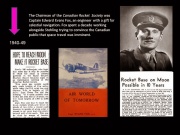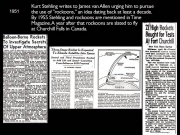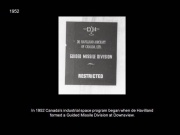100 Years of Aerospace History in Canada: From McCurdy to Hadfield Part 3 by Robert Godwin
From The Space Library
The Canadian Rocket Society Builds a Rocket for the CNE
In 1942 a group of enthusiasts, including Hillel Diamond, a music student at the University of Toronto, created The Canadian Rocket Society (CRS) which was modeled on the German VfR.[i] After the war Kurt Stehling returned to Toronto where he soon became president and founder of The University of Toronto Rocket Society. In January 1948 Stehling publicly debated senior members of the Canadian astronomy community about the promise of space flight and suggested that with its wide open spaces Canada should become a leader in long-range rocket experiments.[ii] In the Spring of 1948 it appears that these two competing societies merged under the CRS banner.
The CRS displayed designs for their "C-1" moon rocket at the Canadian National Exhibition (CNE) in August 1948.[iii] Their model was built by 49-year-old Sam Kernerman in his basement.[iv] Kernerman died in 2000 at the age of 101 having lived in a world before the Wright Brothers all the way through to the International Space Station (ISS).
Other members of the CRS included Captain Edward Cecil Evans Fox (Chair), Kurt Stehling (President), Jack Bird (VP), Boris Duke (VP) and John Wartman (Director) as well as Gordon Patterson, Dean of Aerospace at the University of Toronto.[v]
Chairman Edward Evans Fox was an officer in the Royal Canadian Engineers. A fan of Jules Verne, one of his claims to fame was erecting the steel for the Royal York hotel in the 1920s. In August 1940 he wrote Navigation for Emergencies in which he invented new methods for celestial navigation later used by the RCAF and the USAAF. The success of his method even brought him to the attention of King George VI.
By November 1946 he had generated so much publicity with his talk of moon rockets that he appeared on a radio show named "Canadian Cavalcade" (at the time introduced by Lorne Greene.) During an interview he stated that he expected men to land on the moon within 20 years and that he had written an 80,000 word sequel to his navigation treatise, this time for space navigation.[vi]
In June 1948 in front of a gathering of 100 attendees at the Royal Ontario Museum he and Stehling outlined the aims of the society. Stehling stated, "We are interested in the peacetime use of rockets, not their development for war. We hope to interest the public not only in the mechanical side of rockets but in their social and economic significance."[vii]
That December the group again appeared in the newspapers with their predictions for a manned lunar vehicle to be built by 1960; costing about $5M, 200' high, nuclear powered and taking four days to make the trip. The CRS attracted J.F.Heard, Chairman of the National Research Council, who spoke to their membership in March 1949 on interplanetary travel. Four months later Fox took the plans for their moon rocket to New York where he garnered the attention of the New York Times.
At this time rocketry had become a semi-regular subject at the CNE in Toronto culminating in the appearance of Canada's only captured V-2. The missile had been deftly spirited away from the British in Germany at the end of the war by a handful of Canadians determined to make sure that Canada not be shut out of this particular technological windfall. The V2 attracted considerable attention at its only exhibit appearance that summer.[viii]
Stehling married a girl from Buffalo New York in 1944, in April 1948 he gained resident status in the USA and in May 1950 he left for Buffalo and a position with Bell aircraft's rocket division.[ix] In 1951 Stehling wrote to James van Allen and encouraged him to pursue the use of balloons to launch a rocket into space. Stehling understood large balloons, having been involved with them during his childhood in Germany; he also understood rockets, making him a rare breed at that time. Van Allen seems to be universally credited with the original idea of balloon launch, but it had been around since at least the 1930s and would become known as a "rockoon."[x] Stehling and Van Allen soon began a series of tests with rockoons with the University of Iowa.[xi]
At the Second International Astronautical Congress in London England US Navy Lt Fred Durant informed the delegates that the CRS now had over 100 members (apparently making it the fifth largest such group in the west behind the USA, UK, Germany and France) and that they might well be interested in joining the newly proposed International Astronautical Federation. Of the 13 countries in discussion at the Congress, only Canada (through the CRS) apparently did not commit to becoming a founding member of the IAF.[xii]
In November 1951 Stehling attended the Sixth Annual Convention of the American Rocket Society (ARS) in Atlantic City. He was there to advocate for the establishment of a Niagara ARS chapter due to the wealth of aerospace companies in the Buffalo area. He also stated that his Canadian Rocket Society appeared to welcome a tie-in with the ARS.[xiii] This proposed merger may have ultimately diluted the activities of the CRS which seems to have gone into a prolonged period of decline from this point onwards. Canada's only serious rocket society was later resurrected by Hillel Diamond as an amateur rocket club in the 1960s and in one form or another continues to this day.
In early 1952, DeHavilland UK and DeHavilland Canada set up a Guided Missile Division at Downsview to build the Velvet Glove air-to-air missile. $24 million would be spent on this program over the next three years before it was scrapped in favour of the American manufactured Sparrow missile.[xiv] In July 1957 the Sparrow would also be cancelled, as part of the new NORAD deal to protect North America.[xv]
Despite these costly cancellations the experience gained by DeHavilland's engineers while working on Velvet Glove would serve them well in the following years.
With the cancellation of two missile programs the name of DeHavilland's Guided Missile Division became anathema to the political climate so the name was changed at Downsview to the Special Projects Division.
This small unit of engineers and scientists at Downsview represented the first seed of what would later become Canada's preeminent center of aerospace engineering.[xvi]
Footnotes
[i] http://www.rocketryplanet.com/content/view/3530/29/
[ii] Globe and Mail January 29th 1948
[iii] Ibid. August 28 1948
[iv] Canadian Jewish News Dec 7, 2000
[v] Globe and Mail. April 11 1981
[vi] Toronto Star Nov 25 1946 (Seemingly never published.)
[vii] Ibid. Jun 7 1948
[viii] Globe and Mail Aug 9 1950
[ix] Ancestry.com
[x] Popular Aviation, Space Navigation by Rocket Feb 1937
[xi] Time Magazine Jul 25 1955
[xii] JBIS, Vol 10 Pg 325,331
[xiii] Journal of the American Rocket Society Jan-Feb 1952
[xiv] Phil Lapp Memoir pg 101
[xv] Ibid. Pg 122
[xvi] Ibid. Pg 96



